MGT602 Business Decision Analytics: Case Study and Analysis Report
VerifiedAdded on 2023/05/30
|21
|3949
|222
Case Study
AI Summary
This case study analyzes business decision analytics within the context of a company facing financial difficulties and the need to reduce costs through staff redundancy. The report begins with an executive summary, followed by an introduction that outlines the problem, objectives, and the need to analyze data sources and decision-making systems. The main discussion delves into problem definition, situational analysis, and sense-making using tools like Weka. Potential solutions are formulated and evaluated, with recommendations on how to minimize staff reductions while maintaining profitability. The report emphasizes the importance of data-driven decisions and the application of business analytics to achieve sustainable outcomes. The case study involves a panel tasked with advising on cost-cutting measures, and the team must use available data to determine the most appropriate staff reductions while minimizing the negative impact on the business. The study also compares and contrasts the different data sources and emerging tools and technologies for decision-making. Finally, the report offers recommendations and a conclusion that summarizes the findings and insights gained from the analysis.
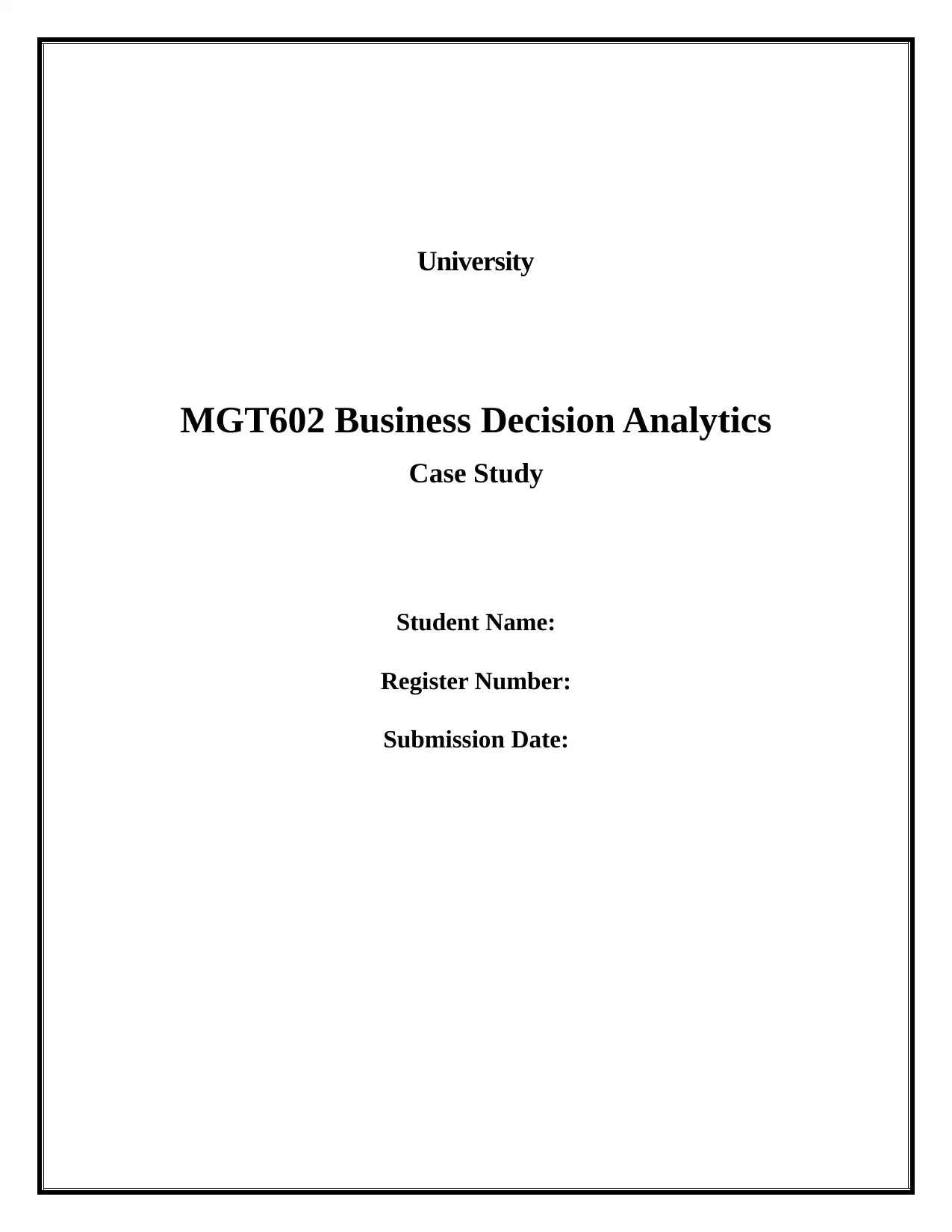
University
MGT602 Business Decision Analytics
Case Study
Student Name:
Register Number:
Submission Date:
MGT602 Business Decision Analytics
Case Study
Student Name:
Register Number:
Submission Date:
Paraphrase This Document
Need a fresh take? Get an instant paraphrase of this document with our AI Paraphraser
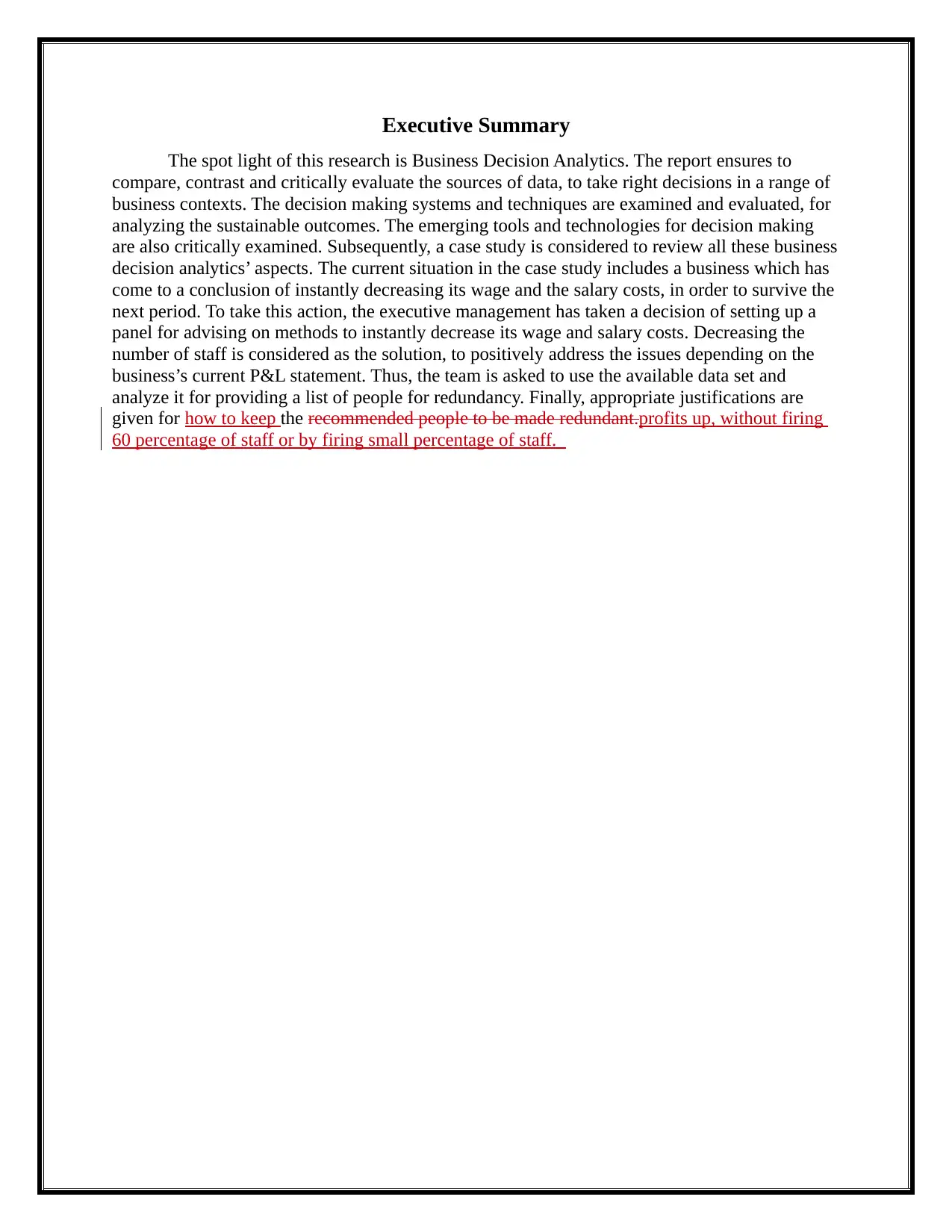
Executive Summary
The spot light of this research is Business Decision Analytics. The report ensures to
compare, contrast and critically evaluate the sources of data, to take right decisions in a range of
business contexts. The decision making systems and techniques are examined and evaluated, for
analyzing the sustainable outcomes. The emerging tools and technologies for decision making
are also critically examined. Subsequently, a case study is considered to review all these business
decision analytics’ aspects. The current situation in the case study includes a business which has
come to a conclusion of instantly decreasing its wage and the salary costs, in order to survive the
next period. To take this action, the executive management has taken a decision of setting up a
panel for advising on methods to instantly decrease its wage and salary costs. Decreasing the
number of staff is considered as the solution, to positively address the issues depending on the
business’s current P&L statement. Thus, the team is asked to use the available data set and
analyze it for providing a list of people for redundancy. Finally, appropriate justifications are
given for how to keep the recommended people to be made redundant.profits up, without firing
60 percentage of staff or by firing small percentage of staff.
The spot light of this research is Business Decision Analytics. The report ensures to
compare, contrast and critically evaluate the sources of data, to take right decisions in a range of
business contexts. The decision making systems and techniques are examined and evaluated, for
analyzing the sustainable outcomes. The emerging tools and technologies for decision making
are also critically examined. Subsequently, a case study is considered to review all these business
decision analytics’ aspects. The current situation in the case study includes a business which has
come to a conclusion of instantly decreasing its wage and the salary costs, in order to survive the
next period. To take this action, the executive management has taken a decision of setting up a
panel for advising on methods to instantly decrease its wage and salary costs. Decreasing the
number of staff is considered as the solution, to positively address the issues depending on the
business’s current P&L statement. Thus, the team is asked to use the available data set and
analyze it for providing a list of people for redundancy. Finally, appropriate justifications are
given for how to keep the recommended people to be made redundant.profits up, without firing
60 percentage of staff or by firing small percentage of staff.
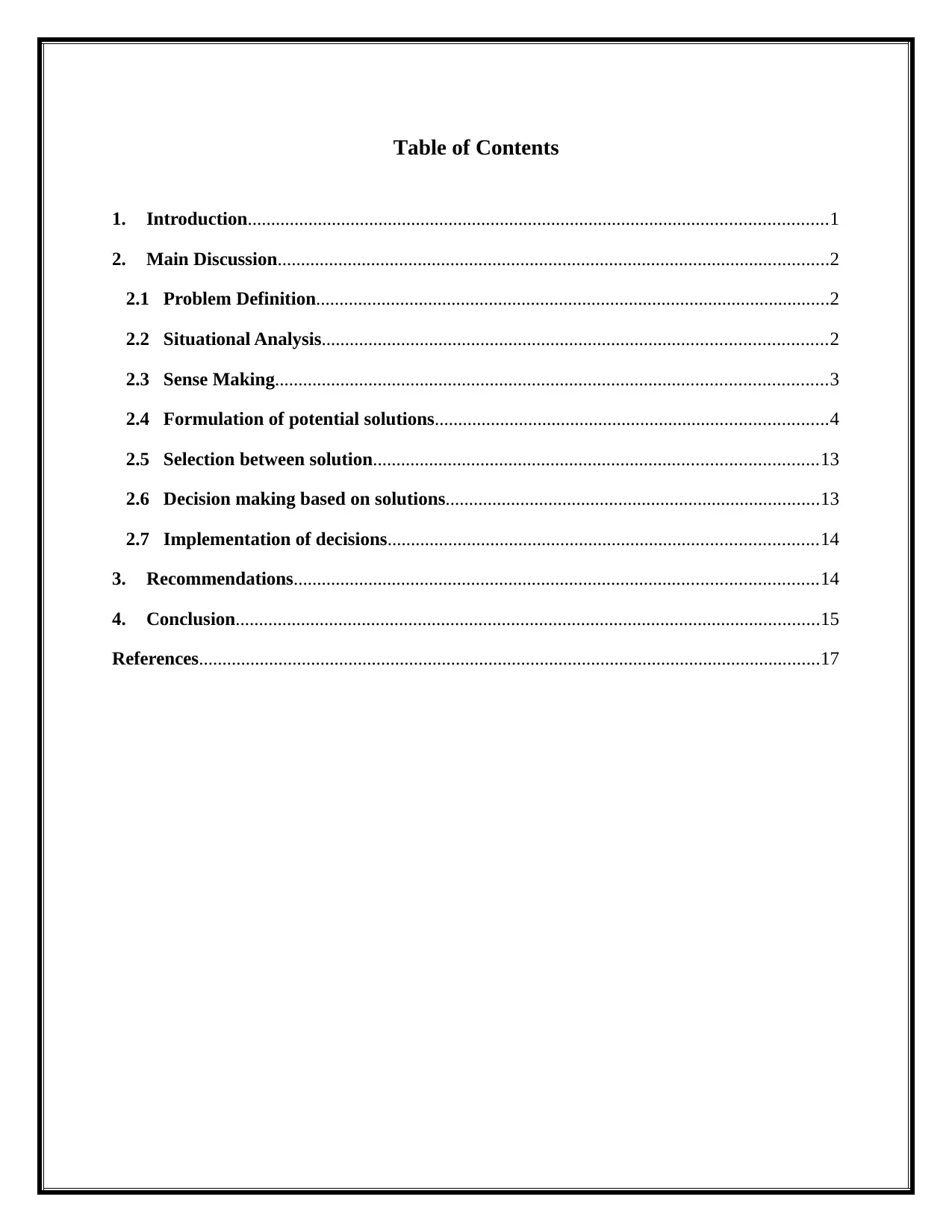
Table of Contents
1. Introduction............................................................................................................................1
2. Main Discussion......................................................................................................................2
2.1 Problem Definition..............................................................................................................2
2.2 Situational Analysis............................................................................................................2
2.3 Sense Making......................................................................................................................3
2.4 Formulation of potential solutions....................................................................................4
2.5 Selection between solution...............................................................................................13
2.6 Decision making based on solutions................................................................................13
2.7 Implementation of decisions............................................................................................14
3. Recommendations................................................................................................................14
4. Conclusion.............................................................................................................................15
References.....................................................................................................................................17
1. Introduction............................................................................................................................1
2. Main Discussion......................................................................................................................2
2.1 Problem Definition..............................................................................................................2
2.2 Situational Analysis............................................................................................................2
2.3 Sense Making......................................................................................................................3
2.4 Formulation of potential solutions....................................................................................4
2.5 Selection between solution...............................................................................................13
2.6 Decision making based on solutions................................................................................13
2.7 Implementation of decisions............................................................................................14
3. Recommendations................................................................................................................14
4. Conclusion.............................................................................................................................15
References.....................................................................................................................................17
⊘ This is a preview!⊘
Do you want full access?
Subscribe today to unlock all pages.

Trusted by 1+ million students worldwide
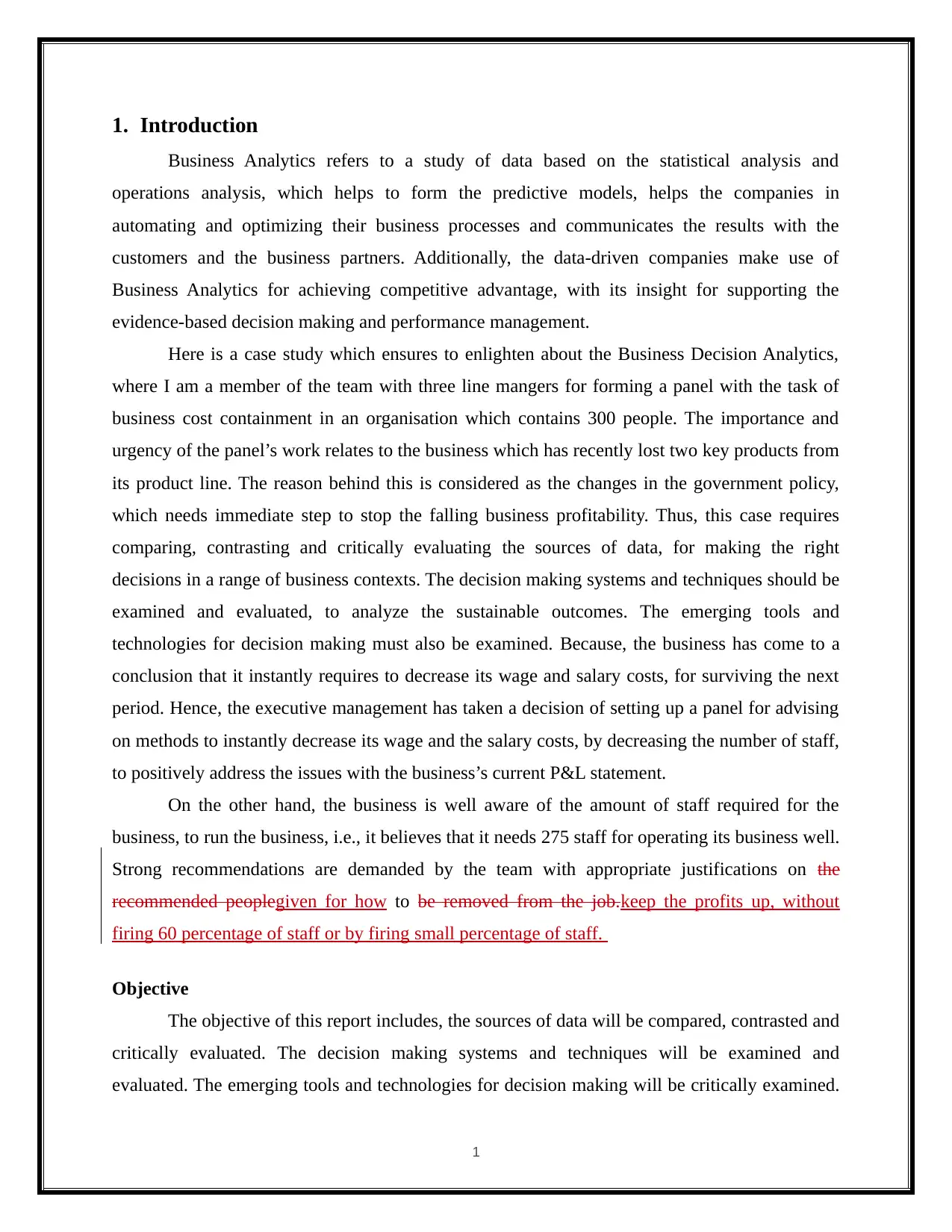
1. Introduction
Business Analytics refers to a study of data based on the statistical analysis and
operations analysis, which helps to form the predictive models, helps the companies in
automating and optimizing their business processes and communicates the results with the
customers and the business partners. Additionally, the data-driven companies make use of
Business Analytics for achieving competitive advantage, with its insight for supporting the
evidence-based decision making and performance management.
Here is a case study which ensures to enlighten about the Business Decision Analytics,
where I am a member of the team with three line mangers for forming a panel with the task of
business cost containment in an organisation which contains 300 people. The importance and
urgency of the panel’s work relates to the business which has recently lost two key products from
its product line. The reason behind this is considered as the changes in the government policy,
which needs immediate step to stop the falling business profitability. Thus, this case requires
comparing, contrasting and critically evaluating the sources of data, for making the right
decisions in a range of business contexts. The decision making systems and techniques should be
examined and evaluated, to analyze the sustainable outcomes. The emerging tools and
technologies for decision making must also be examined. Because, the business has come to a
conclusion that it instantly requires to decrease its wage and salary costs, for surviving the next
period. Hence, the executive management has taken a decision of setting up a panel for advising
on methods to instantly decrease its wage and the salary costs, by decreasing the number of staff,
to positively address the issues with the business’s current P&L statement.
On the other hand, the business is well aware of the amount of staff required for the
business, to run the business, i.e., it believes that it needs 275 staff for operating its business well.
Strong recommendations are demanded by the team with appropriate justifications on the
recommended peoplegiven for how to be removed from the job.keep the profits up, without
firing 60 percentage of staff or by firing small percentage of staff.
Objective
The objective of this report includes, the sources of data will be compared, contrasted and
critically evaluated. The decision making systems and techniques will be examined and
evaluated. The emerging tools and technologies for decision making will be critically examined.
1
Business Analytics refers to a study of data based on the statistical analysis and
operations analysis, which helps to form the predictive models, helps the companies in
automating and optimizing their business processes and communicates the results with the
customers and the business partners. Additionally, the data-driven companies make use of
Business Analytics for achieving competitive advantage, with its insight for supporting the
evidence-based decision making and performance management.
Here is a case study which ensures to enlighten about the Business Decision Analytics,
where I am a member of the team with three line mangers for forming a panel with the task of
business cost containment in an organisation which contains 300 people. The importance and
urgency of the panel’s work relates to the business which has recently lost two key products from
its product line. The reason behind this is considered as the changes in the government policy,
which needs immediate step to stop the falling business profitability. Thus, this case requires
comparing, contrasting and critically evaluating the sources of data, for making the right
decisions in a range of business contexts. The decision making systems and techniques should be
examined and evaluated, to analyze the sustainable outcomes. The emerging tools and
technologies for decision making must also be examined. Because, the business has come to a
conclusion that it instantly requires to decrease its wage and salary costs, for surviving the next
period. Hence, the executive management has taken a decision of setting up a panel for advising
on methods to instantly decrease its wage and the salary costs, by decreasing the number of staff,
to positively address the issues with the business’s current P&L statement.
On the other hand, the business is well aware of the amount of staff required for the
business, to run the business, i.e., it believes that it needs 275 staff for operating its business well.
Strong recommendations are demanded by the team with appropriate justifications on the
recommended peoplegiven for how to be removed from the job.keep the profits up, without
firing 60 percentage of staff or by firing small percentage of staff.
Objective
The objective of this report includes, the sources of data will be compared, contrasted and
critically evaluated. The decision making systems and techniques will be examined and
evaluated. The emerging tools and technologies for decision making will be critically examined.
1
Paraphrase This Document
Need a fresh take? Get an instant paraphrase of this document with our AI Paraphraser
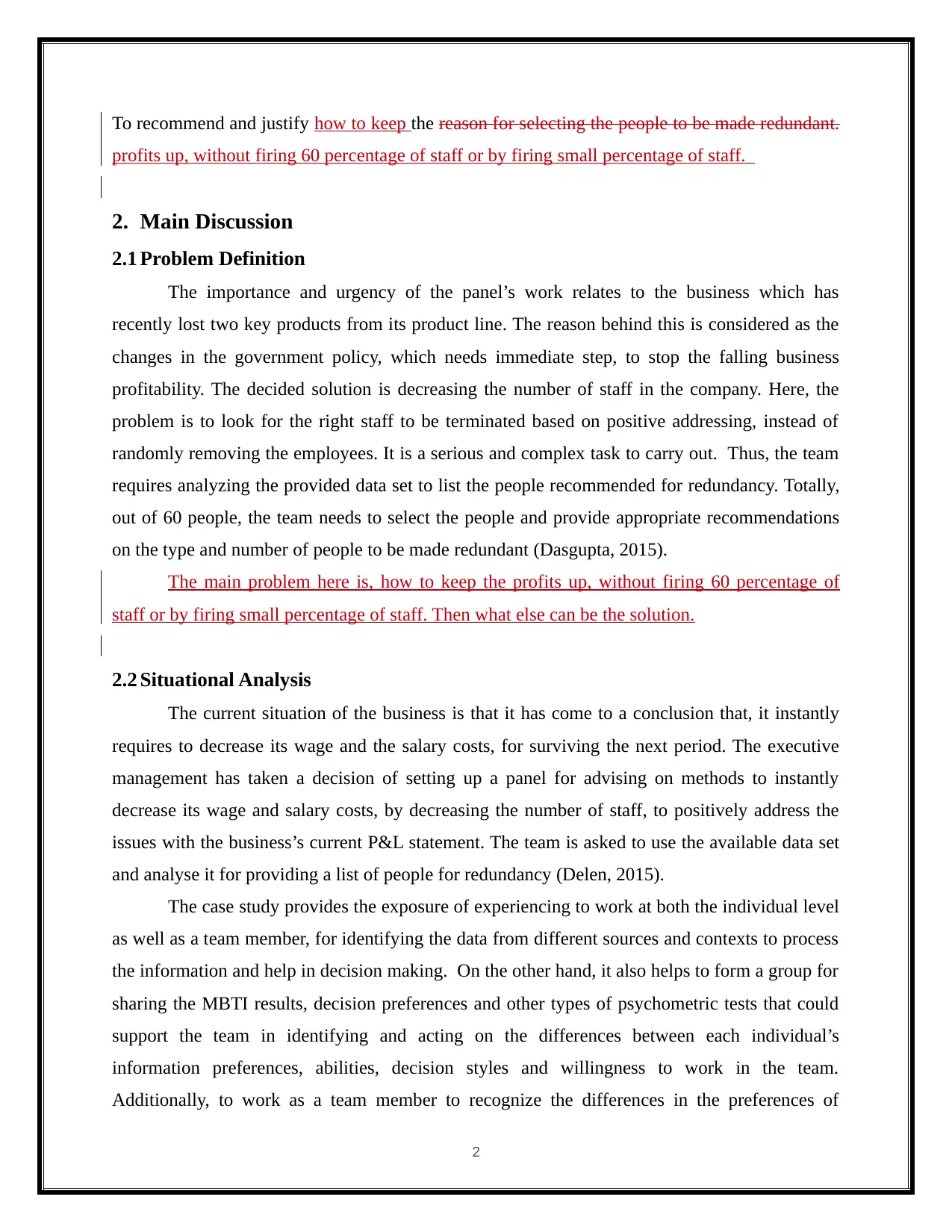
To recommend and justify how to keep the reason for selecting the people to be made redundant.
profits up, without firing 60 percentage of staff or by firing small percentage of staff.
2. Main Discussion
2.1 Problem Definition
The importance and urgency of the panel’s work relates to the business which has
recently lost two key products from its product line. The reason behind this is considered as the
changes in the government policy, which needs immediate step, to stop the falling business
profitability. The decided solution is decreasing the number of staff in the company. Here, the
problem is to look for the right staff to be terminated based on positive addressing, instead of
randomly removing the employees. It is a serious and complex task to carry out. Thus, the team
requires analyzing the provided data set to list the people recommended for redundancy. Totally,
out of 60 people, the team needs to select the people and provide appropriate recommendations
on the type and number of people to be made redundant (Dasgupta, 2015).
The main problem here is, how to keep the profits up, without firing 60 percentage of
staff or by firing small percentage of staff. Then what else can be the solution.
2.2 Situational Analysis
The current situation of the business is that it has come to a conclusion that, it instantly
requires to decrease its wage and the salary costs, for surviving the next period. The executive
management has taken a decision of setting up a panel for advising on methods to instantly
decrease its wage and salary costs, by decreasing the number of staff, to positively address the
issues with the business’s current P&L statement. The team is asked to use the available data set
and analyse it for providing a list of people for redundancy (Delen, 2015).
The case study provides the exposure of experiencing to work at both the individual level
as well as a team member, for identifying the data from different sources and contexts to process
the information and help in decision making. On the other hand, it also helps to form a group for
sharing the MBTI results, decision preferences and other types of psychometric tests that could
support the team in identifying and acting on the differences between each individual’s
information preferences, abilities, decision styles and willingness to work in the team.
Additionally, to work as a team member to recognize the differences in the preferences of
2
profits up, without firing 60 percentage of staff or by firing small percentage of staff.
2. Main Discussion
2.1 Problem Definition
The importance and urgency of the panel’s work relates to the business which has
recently lost two key products from its product line. The reason behind this is considered as the
changes in the government policy, which needs immediate step, to stop the falling business
profitability. The decided solution is decreasing the number of staff in the company. Here, the
problem is to look for the right staff to be terminated based on positive addressing, instead of
randomly removing the employees. It is a serious and complex task to carry out. Thus, the team
requires analyzing the provided data set to list the people recommended for redundancy. Totally,
out of 60 people, the team needs to select the people and provide appropriate recommendations
on the type and number of people to be made redundant (Dasgupta, 2015).
The main problem here is, how to keep the profits up, without firing 60 percentage of
staff or by firing small percentage of staff. Then what else can be the solution.
2.2 Situational Analysis
The current situation of the business is that it has come to a conclusion that, it instantly
requires to decrease its wage and the salary costs, for surviving the next period. The executive
management has taken a decision of setting up a panel for advising on methods to instantly
decrease its wage and salary costs, by decreasing the number of staff, to positively address the
issues with the business’s current P&L statement. The team is asked to use the available data set
and analyse it for providing a list of people for redundancy (Delen, 2015).
The case study provides the exposure of experiencing to work at both the individual level
as well as a team member, for identifying the data from different sources and contexts to process
the information and help in decision making. On the other hand, it also helps to form a group for
sharing the MBTI results, decision preferences and other types of psychometric tests that could
support the team in identifying and acting on the differences between each individual’s
information preferences, abilities, decision styles and willingness to work in the team.
Additionally, to work as a team member to recognize the differences in the preferences of
2
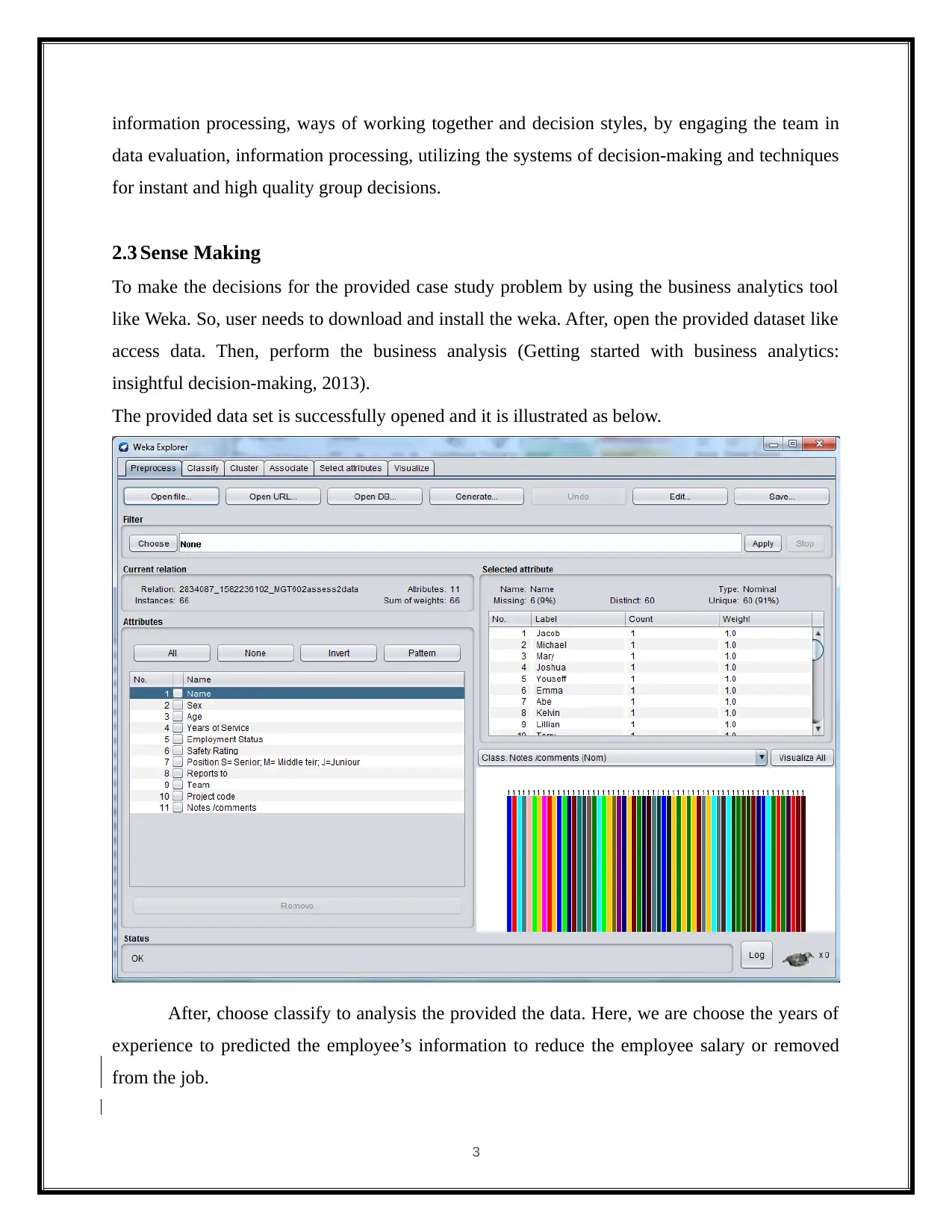
information processing, ways of working together and decision styles, by engaging the team in
data evaluation, information processing, utilizing the systems of decision-making and techniques
for instant and high quality group decisions.
2.3 Sense Making
To make the decisions for the provided case study problem by using the business analytics tool
like Weka. So, user needs to download and install the weka. After, open the provided dataset like
access data. Then, perform the business analysis (Getting started with business analytics:
insightful decision-making, 2013).
The provided data set is successfully opened and it is illustrated as below.
After, choose classify to analysis the provided the data. Here, we are choose the years of
experience to predicted the employee’s information to reduce the employee salary or removed
from the job.
3
data evaluation, information processing, utilizing the systems of decision-making and techniques
for instant and high quality group decisions.
2.3 Sense Making
To make the decisions for the provided case study problem by using the business analytics tool
like Weka. So, user needs to download and install the weka. After, open the provided dataset like
access data. Then, perform the business analysis (Getting started with business analytics:
insightful decision-making, 2013).
The provided data set is successfully opened and it is illustrated as below.
After, choose classify to analysis the provided the data. Here, we are choose the years of
experience to predicted the employee’s information to reduce the employee salary or removed
from the job.
3
⊘ This is a preview!⊘
Do you want full access?
Subscribe today to unlock all pages.

Trusted by 1+ million students worldwide
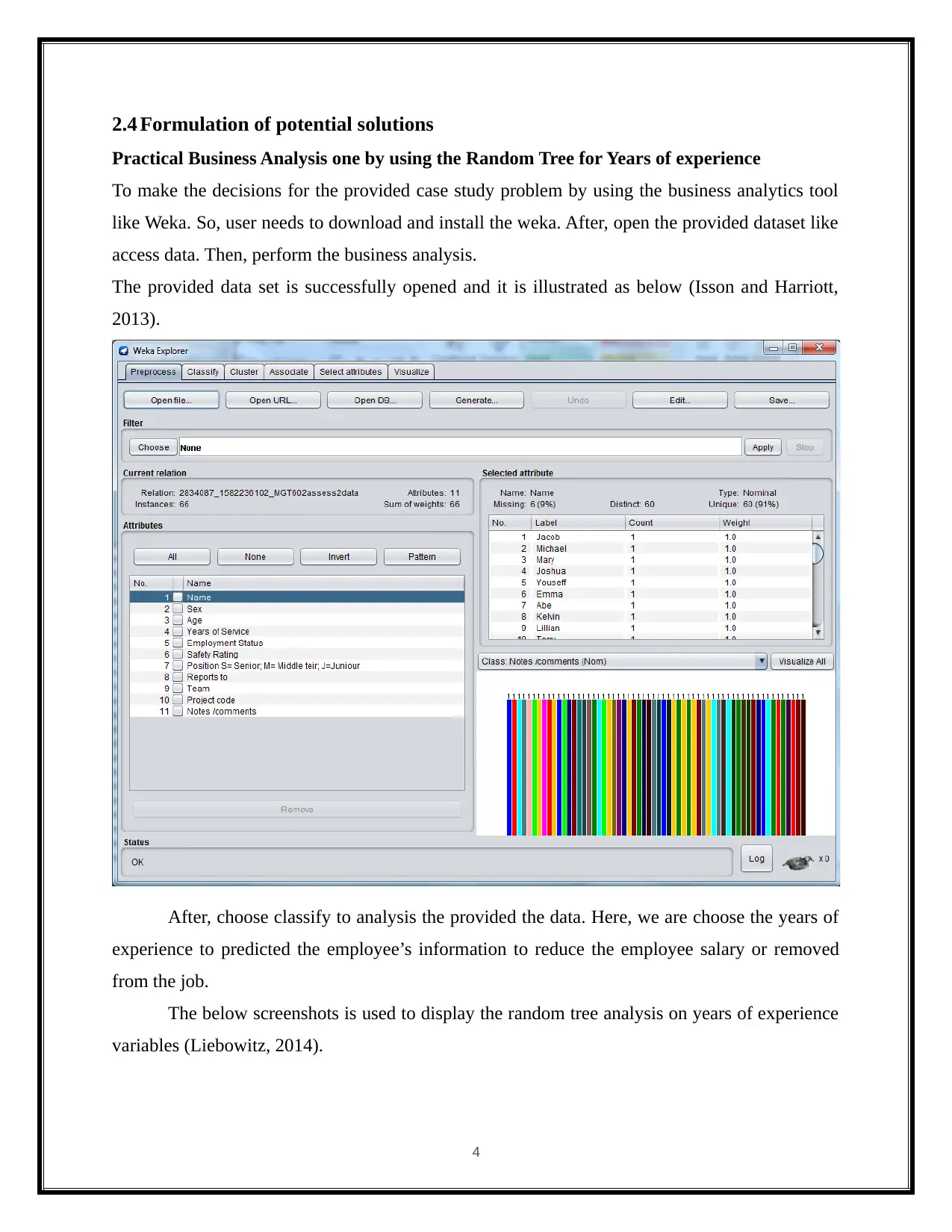
2.4 Formulation of potential solutions
Practical Business Analysis one by using the Random Tree for Years of experience
To make the decisions for the provided case study problem by using the business analytics tool
like Weka. So, user needs to download and install the weka. After, open the provided dataset like
access data. Then, perform the business analysis.
The provided data set is successfully opened and it is illustrated as below (Isson and Harriott,
2013).
After, choose classify to analysis the provided the data. Here, we are choose the years of
experience to predicted the employee’s information to reduce the employee salary or removed
from the job.
The below screenshots is used to display the random tree analysis on years of experience
variables (Liebowitz, 2014).
4
Practical Business Analysis one by using the Random Tree for Years of experience
To make the decisions for the provided case study problem by using the business analytics tool
like Weka. So, user needs to download and install the weka. After, open the provided dataset like
access data. Then, perform the business analysis.
The provided data set is successfully opened and it is illustrated as below (Isson and Harriott,
2013).
After, choose classify to analysis the provided the data. Here, we are choose the years of
experience to predicted the employee’s information to reduce the employee salary or removed
from the job.
The below screenshots is used to display the random tree analysis on years of experience
variables (Liebowitz, 2014).
4
Paraphrase This Document
Need a fresh take? Get an instant paraphrase of this document with our AI Paraphraser
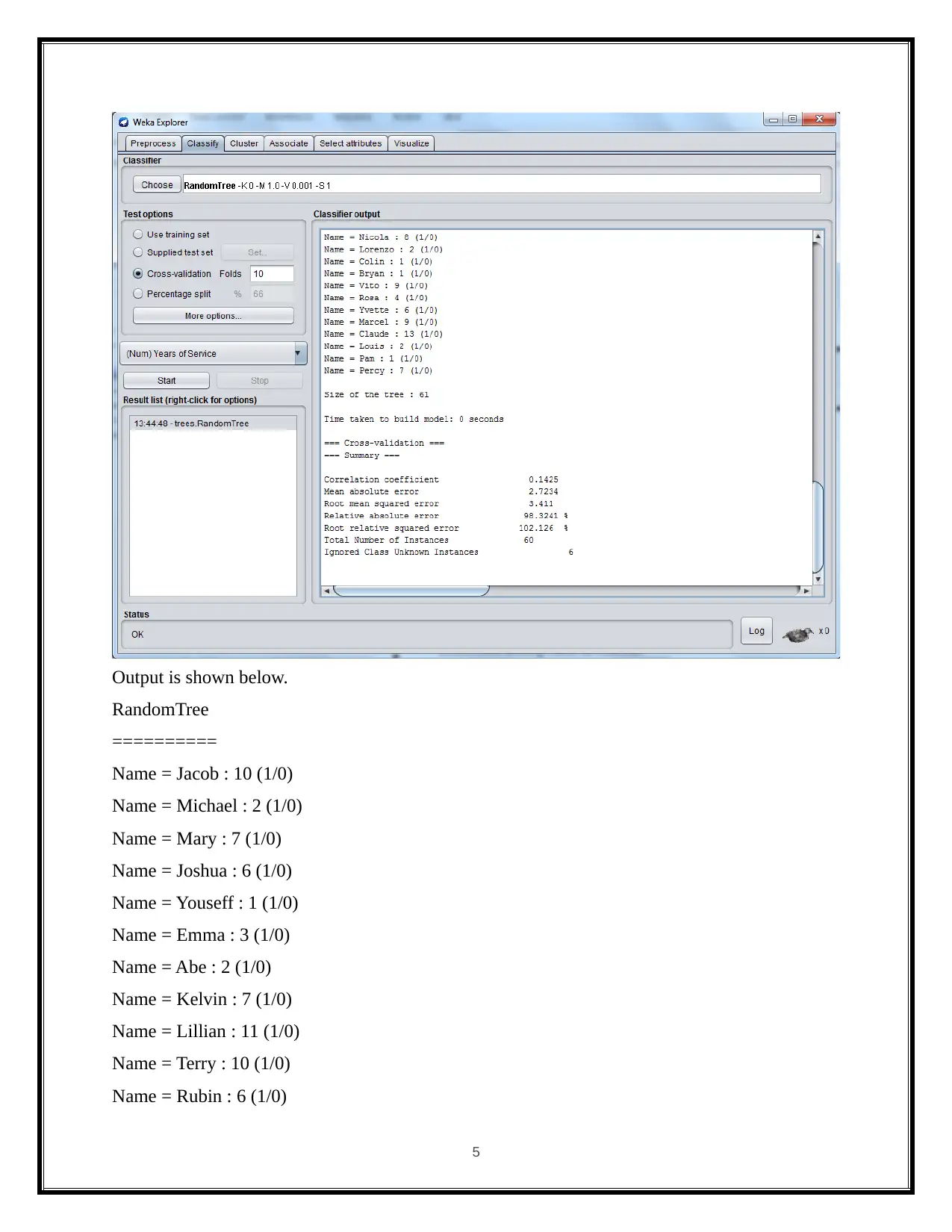
Output is shown below.
RandomTree
==========
Name = Jacob : 10 (1/0)
Name = Michael : 2 (1/0)
Name = Mary : 7 (1/0)
Name = Joshua : 6 (1/0)
Name = Youseff : 1 (1/0)
Name = Emma : 3 (1/0)
Name = Abe : 2 (1/0)
Name = Kelvin : 7 (1/0)
Name = Lillian : 11 (1/0)
Name = Terry : 10 (1/0)
Name = Rubin : 6 (1/0)
5
RandomTree
==========
Name = Jacob : 10 (1/0)
Name = Michael : 2 (1/0)
Name = Mary : 7 (1/0)
Name = Joshua : 6 (1/0)
Name = Youseff : 1 (1/0)
Name = Emma : 3 (1/0)
Name = Abe : 2 (1/0)
Name = Kelvin : 7 (1/0)
Name = Lillian : 11 (1/0)
Name = Terry : 10 (1/0)
Name = Rubin : 6 (1/0)
5
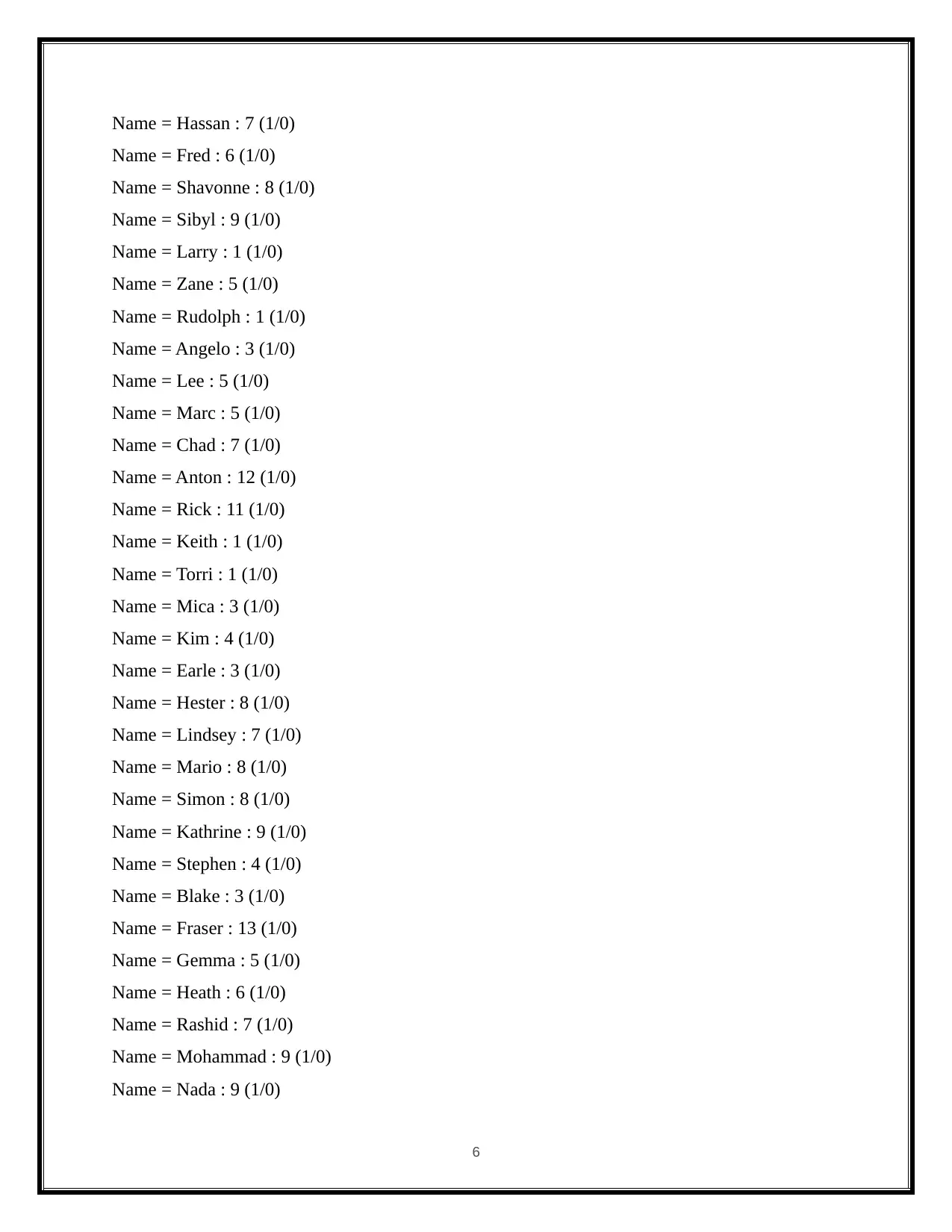
Name = Hassan : 7 (1/0)
Name = Fred : 6 (1/0)
Name = Shavonne : 8 (1/0)
Name = Sibyl : 9 (1/0)
Name = Larry : 1 (1/0)
Name = Zane : 5 (1/0)
Name = Rudolph : 1 (1/0)
Name = Angelo : 3 (1/0)
Name = Lee : 5 (1/0)
Name = Marc : 5 (1/0)
Name = Chad : 7 (1/0)
Name = Anton : 12 (1/0)
Name = Rick : 11 (1/0)
Name = Keith : 1 (1/0)
Name = Torri : 1 (1/0)
Name = Mica : 3 (1/0)
Name = Kim : 4 (1/0)
Name = Earle : 3 (1/0)
Name = Hester : 8 (1/0)
Name = Lindsey : 7 (1/0)
Name = Mario : 8 (1/0)
Name = Simon : 8 (1/0)
Name = Kathrine : 9 (1/0)
Name = Stephen : 4 (1/0)
Name = Blake : 3 (1/0)
Name = Fraser : 13 (1/0)
Name = Gemma : 5 (1/0)
Name = Heath : 6 (1/0)
Name = Rashid : 7 (1/0)
Name = Mohammad : 9 (1/0)
Name = Nada : 9 (1/0)
6
Name = Fred : 6 (1/0)
Name = Shavonne : 8 (1/0)
Name = Sibyl : 9 (1/0)
Name = Larry : 1 (1/0)
Name = Zane : 5 (1/0)
Name = Rudolph : 1 (1/0)
Name = Angelo : 3 (1/0)
Name = Lee : 5 (1/0)
Name = Marc : 5 (1/0)
Name = Chad : 7 (1/0)
Name = Anton : 12 (1/0)
Name = Rick : 11 (1/0)
Name = Keith : 1 (1/0)
Name = Torri : 1 (1/0)
Name = Mica : 3 (1/0)
Name = Kim : 4 (1/0)
Name = Earle : 3 (1/0)
Name = Hester : 8 (1/0)
Name = Lindsey : 7 (1/0)
Name = Mario : 8 (1/0)
Name = Simon : 8 (1/0)
Name = Kathrine : 9 (1/0)
Name = Stephen : 4 (1/0)
Name = Blake : 3 (1/0)
Name = Fraser : 13 (1/0)
Name = Gemma : 5 (1/0)
Name = Heath : 6 (1/0)
Name = Rashid : 7 (1/0)
Name = Mohammad : 9 (1/0)
Name = Nada : 9 (1/0)
6
⊘ This is a preview!⊘
Do you want full access?
Subscribe today to unlock all pages.

Trusted by 1+ million students worldwide
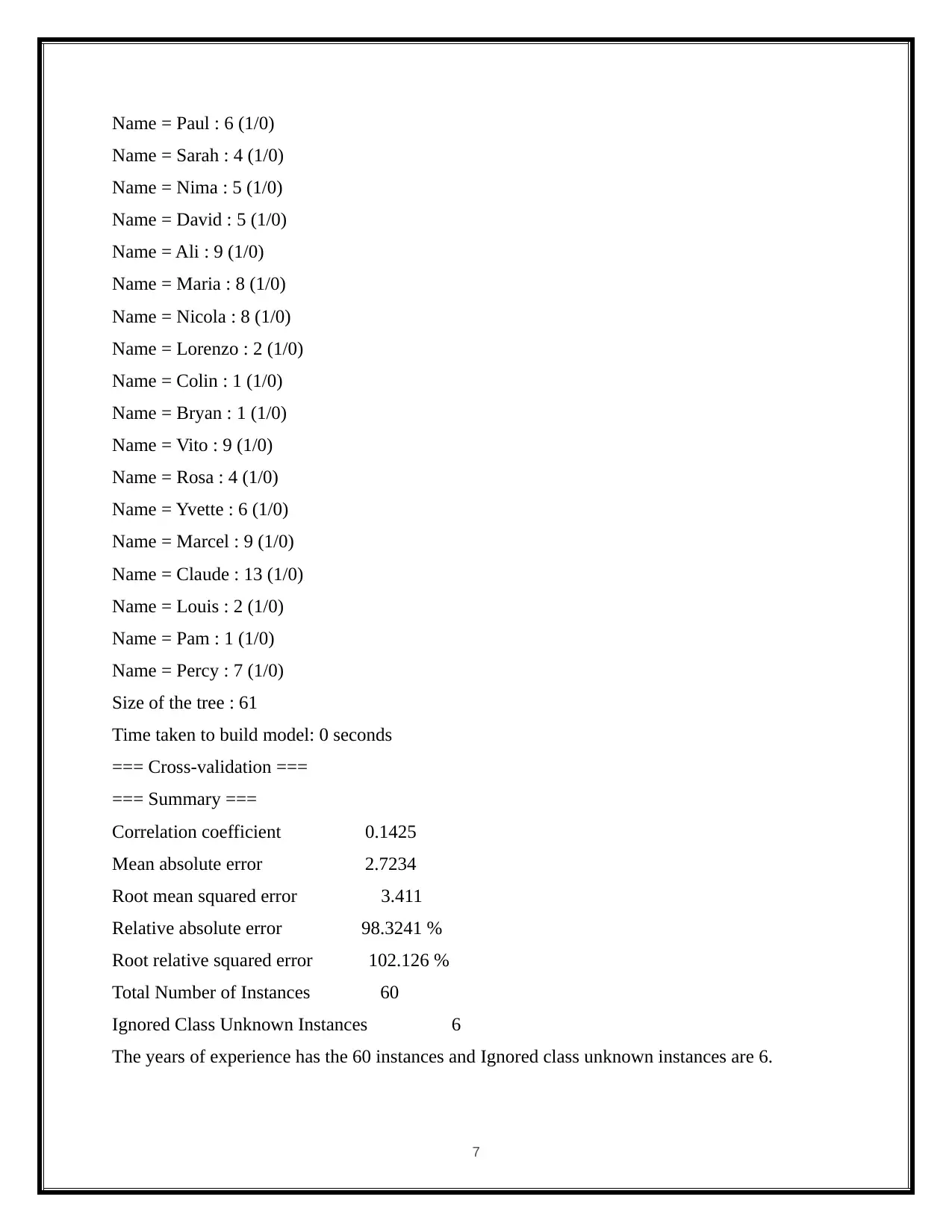
Name = Paul : 6 (1/0)
Name = Sarah : 4 (1/0)
Name = Nima : 5 (1/0)
Name = David : 5 (1/0)
Name = Ali : 9 (1/0)
Name = Maria : 8 (1/0)
Name = Nicola : 8 (1/0)
Name = Lorenzo : 2 (1/0)
Name = Colin : 1 (1/0)
Name = Bryan : 1 (1/0)
Name = Vito : 9 (1/0)
Name = Rosa : 4 (1/0)
Name = Yvette : 6 (1/0)
Name = Marcel : 9 (1/0)
Name = Claude : 13 (1/0)
Name = Louis : 2 (1/0)
Name = Pam : 1 (1/0)
Name = Percy : 7 (1/0)
Size of the tree : 61
Time taken to build model: 0 seconds
=== Cross-validation ===
=== Summary ===
Correlation coefficient 0.1425
Mean absolute error 2.7234
Root mean squared error 3.411
Relative absolute error 98.3241 %
Root relative squared error 102.126 %
Total Number of Instances 60
Ignored Class Unknown Instances 6
The years of experience has the 60 instances and Ignored class unknown instances are 6.
7
Name = Sarah : 4 (1/0)
Name = Nima : 5 (1/0)
Name = David : 5 (1/0)
Name = Ali : 9 (1/0)
Name = Maria : 8 (1/0)
Name = Nicola : 8 (1/0)
Name = Lorenzo : 2 (1/0)
Name = Colin : 1 (1/0)
Name = Bryan : 1 (1/0)
Name = Vito : 9 (1/0)
Name = Rosa : 4 (1/0)
Name = Yvette : 6 (1/0)
Name = Marcel : 9 (1/0)
Name = Claude : 13 (1/0)
Name = Louis : 2 (1/0)
Name = Pam : 1 (1/0)
Name = Percy : 7 (1/0)
Size of the tree : 61
Time taken to build model: 0 seconds
=== Cross-validation ===
=== Summary ===
Correlation coefficient 0.1425
Mean absolute error 2.7234
Root mean squared error 3.411
Relative absolute error 98.3241 %
Root relative squared error 102.126 %
Total Number of Instances 60
Ignored Class Unknown Instances 6
The years of experience has the 60 instances and Ignored class unknown instances are 6.
7
Paraphrase This Document
Need a fresh take? Get an instant paraphrase of this document with our AI Paraphraser
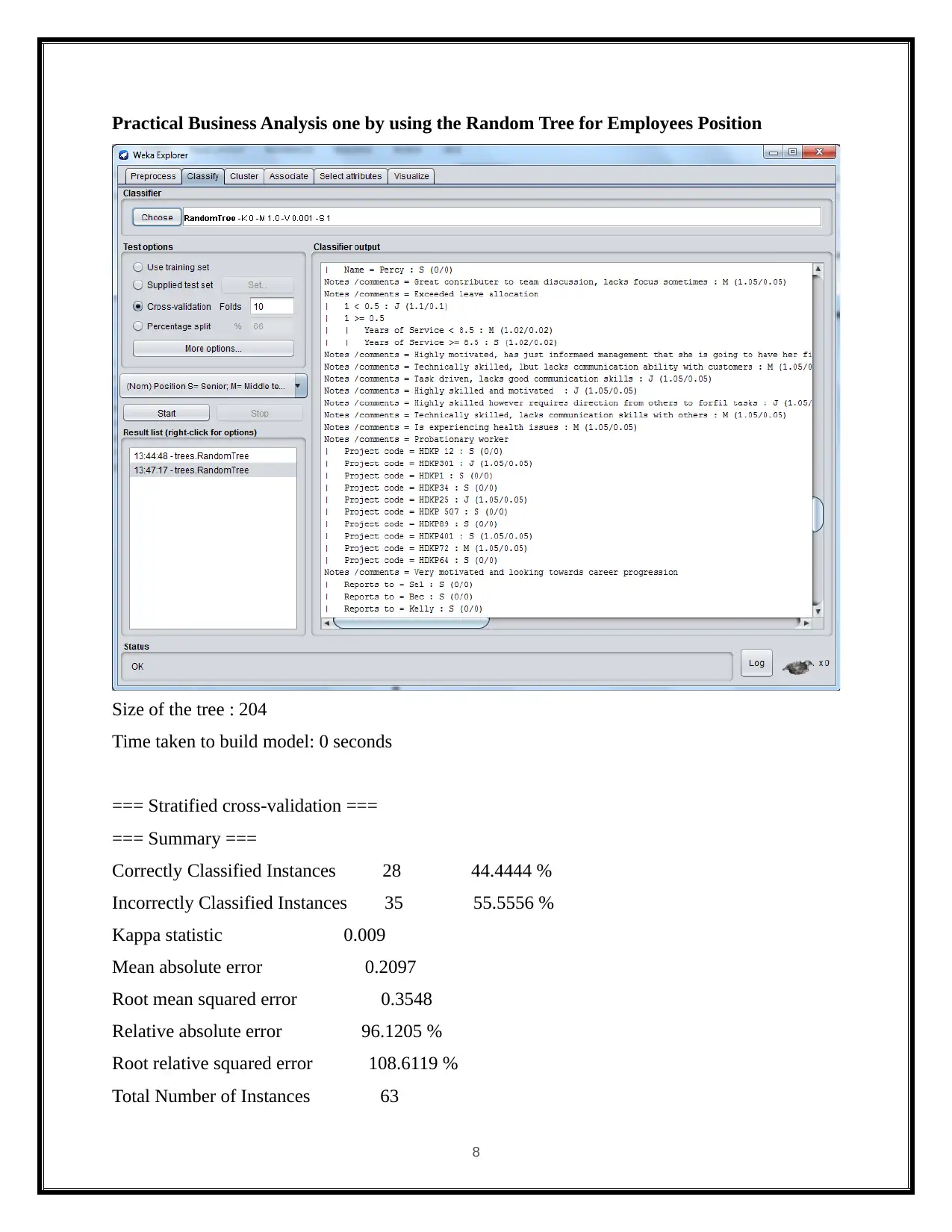
Practical Business Analysis one by using the Random Tree for Employees Position
Size of the tree : 204
Time taken to build model: 0 seconds
=== Stratified cross-validation ===
=== Summary ===
Correctly Classified Instances 28 44.4444 %
Incorrectly Classified Instances 35 55.5556 %
Kappa statistic 0.009
Mean absolute error 0.2097
Root mean squared error 0.3548
Relative absolute error 96.1205 %
Root relative squared error 108.6119 %
Total Number of Instances 63
8
Size of the tree : 204
Time taken to build model: 0 seconds
=== Stratified cross-validation ===
=== Summary ===
Correctly Classified Instances 28 44.4444 %
Incorrectly Classified Instances 35 55.5556 %
Kappa statistic 0.009
Mean absolute error 0.2097
Root mean squared error 0.3548
Relative absolute error 96.1205 %
Root relative squared error 108.6119 %
Total Number of Instances 63
8
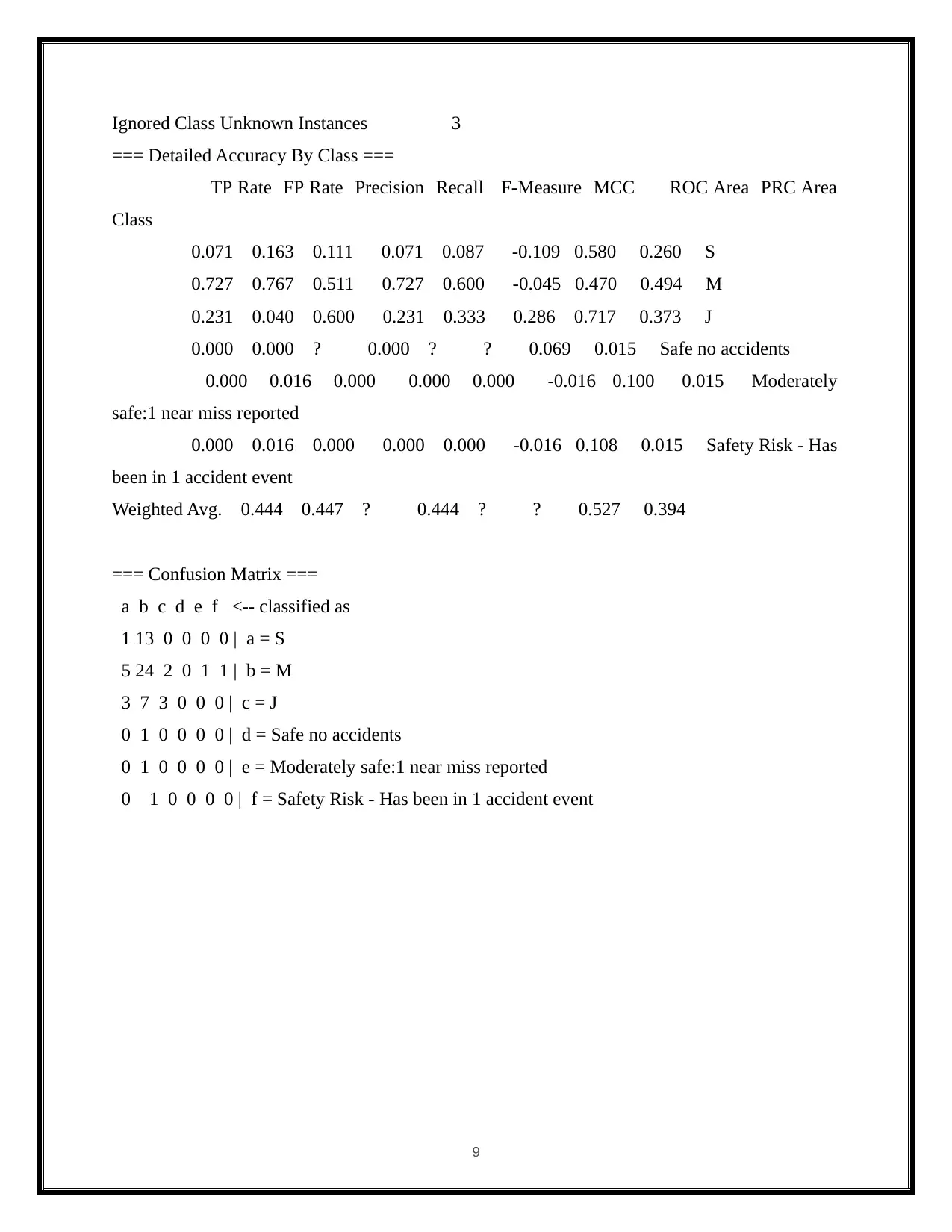
Ignored Class Unknown Instances 3
=== Detailed Accuracy By Class ===
TP Rate FP Rate Precision Recall F-Measure MCC ROC Area PRC Area
Class
0.071 0.163 0.111 0.071 0.087 -0.109 0.580 0.260 S
0.727 0.767 0.511 0.727 0.600 -0.045 0.470 0.494 M
0.231 0.040 0.600 0.231 0.333 0.286 0.717 0.373 J
0.000 0.000 ? 0.000 ? ? 0.069 0.015 Safe no accidents
0.000 0.016 0.000 0.000 0.000 -0.016 0.100 0.015 Moderately
safe:1 near miss reported
0.000 0.016 0.000 0.000 0.000 -0.016 0.108 0.015 Safety Risk - Has
been in 1 accident event
Weighted Avg. 0.444 0.447 ? 0.444 ? ? 0.527 0.394
=== Confusion Matrix ===
a b c d e f <-- classified as
1 13 0 0 0 0 | a = S
5 24 2 0 1 1 | b = M
3 7 3 0 0 0 | c = J
0 1 0 0 0 0 | d = Safe no accidents
0 1 0 0 0 0 | e = Moderately safe:1 near miss reported
0 1 0 0 0 0 | f = Safety Risk - Has been in 1 accident event
9
=== Detailed Accuracy By Class ===
TP Rate FP Rate Precision Recall F-Measure MCC ROC Area PRC Area
Class
0.071 0.163 0.111 0.071 0.087 -0.109 0.580 0.260 S
0.727 0.767 0.511 0.727 0.600 -0.045 0.470 0.494 M
0.231 0.040 0.600 0.231 0.333 0.286 0.717 0.373 J
0.000 0.000 ? 0.000 ? ? 0.069 0.015 Safe no accidents
0.000 0.016 0.000 0.000 0.000 -0.016 0.100 0.015 Moderately
safe:1 near miss reported
0.000 0.016 0.000 0.000 0.000 -0.016 0.108 0.015 Safety Risk - Has
been in 1 accident event
Weighted Avg. 0.444 0.447 ? 0.444 ? ? 0.527 0.394
=== Confusion Matrix ===
a b c d e f <-- classified as
1 13 0 0 0 0 | a = S
5 24 2 0 1 1 | b = M
3 7 3 0 0 0 | c = J
0 1 0 0 0 0 | d = Safe no accidents
0 1 0 0 0 0 | e = Moderately safe:1 near miss reported
0 1 0 0 0 0 | f = Safety Risk - Has been in 1 accident event
9
⊘ This is a preview!⊘
Do you want full access?
Subscribe today to unlock all pages.

Trusted by 1+ million students worldwide
1 out of 21
Related Documents
Your All-in-One AI-Powered Toolkit for Academic Success.
+13062052269
info@desklib.com
Available 24*7 on WhatsApp / Email
![[object Object]](/_next/static/media/star-bottom.7253800d.svg)
Unlock your academic potential
Copyright © 2020–2025 A2Z Services. All Rights Reserved. Developed and managed by ZUCOL.





